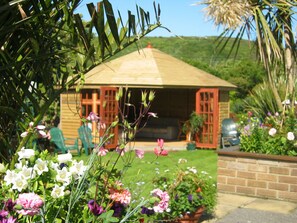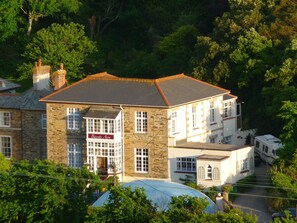BASSETS LOOKOUT~ WONDERFUL VIEWS OVER THE VALLEY AND SEA, WITH FREE WIFI,
THE ELEGANT THREE BEDROOM APARTMENT HAS A SPACIOUS OPEN PLAN LIVING ROOM WITH SEA AND VALLEY VIEWS, A GALLEY KITCHEN AND PINE DINING AREA
THE LOVELY LARGE BATHROOM HAS AN OVER BATH ELECTRIC SHOWER, SINK AND W.C
READ OUR REVIEWS ON TRIPADVISOR
BASSETS ACRE, BUILT BY LORD DE DUNSTANVILLE BASSETS ACRE, circa 1827
Six superb 1-3 bedroom historic apartments encapsulated in the grand Victorian villa set in an acre of sub- tropical gardens, just 5 minutes walk from the beautiful Portreath sandy bay, Harbour, Pubs, Shops and Restaurants,The stunning coastal path is just on our doorstep
In the front garden there is a Gazebo dining area, Loungers, Barbecue and childrens play area, an ideal place to relax while the family are enjoying themselves and you can relax with a good book and a glass of wine!
We have taken health and safety instruction to ensure the
Swimming pool, Hot tub and all areas are safe to use,
There is no evidence that COVID-19 can spread to people through the water used in pools, hot tubs, or water playgrounds. Proper operation and disinfection of pools, hot tubs, and water playgrounds should kill the virus that causes COVID-19.
The telescopic heated SWIMMING POOL enclosure, lets you enjoy the pool whatever the weather (May to end of Sept) and the HOT TUB / MASSAGE SPA is FAB,
There is also the games room with Pool table, football table, lots of games books and a DVD library, All this and more just a short stroll to the Beach, Pubs, Shops, Restaurants and stunning cliff and woodland walks.
In the front garden, there is a Gazebo dining area, Loungers,Barbecue and childrens play area, an ideal place to relax while the family are enjoying themselves and you can relax with a good book and a glass of wine !
There is also the games room with Pool table, football table, lots of games books and a DVD library, All this and more just a short stroll to the Beach, Pubs, Shops, Restaurants and stunning cliff and woodland walks.
Our games room has something for everyone with pool and football tables.
BASSETS ACRE, is beautifully sited in a little wooded valley with a stream flowing through spacious gardens to the sea. There are two private car parks.
The front garden, with its pool and children's play area, are equipped with BARBECUES and all the facilities for eating out and relaxing.
We pride ourselves on the quality and comfort of all the apartments that have FREE WiFi.
Portreath, is a UNESCO World Heritage Site and is surrounded by National Trust land. For its size it has a surprising amount to offer with its two beautiful, sandy beaches: watersports such as swimming, surfing, canoeing, fishing and surfing school; footpaths and cycle tracks connect with networks right across the peninsula through the old mining areas; a whole, rich, industrial history to be explored.The village has shops, including a bakery and a mini market, that provide for all daily needs: two beachside cafes and no less than three pubs with restaurant facilities and outdoor eating areas. Not far from the village is a golf course, riding stables, dry ski slope, skateboard and BMX trak
Portreath (Cornish: Porthtreth or Porth Treth)[2] is a civil parish, village and fishing port on the north coast of Cornwall, England, United Kingdom. The village is about three miles (5 km) northwest of Redruth.[3] The village extends along both sides of a stream valley and is centred on the harbour and beach. West of the harbour entrance and breakwater are two sandy beaches which are popular with holidaymakers and surfers.
Portreath lies within the Cornwall Area of Outstanding Natural Beauty (AONB). Almost a third of Cornwall has AONB designation, with the same status and protection as a National Park. Separately, in early 2017, the village was looking to be a hedgehog friendly village.[4] It would join Burton Fleming in East Yorkshire as one of a handful of hedgehog friendly villages in the UK.[5]
History
The name Portreath (meaning "sandy cove") was first recorded in 1485 and tin streaming in the valley was recorded from 1602. Devon contractor Samuel Nott, was engaged to build the first mole (or quay) in 1713 on the western side of the beach, near Amy's Point.[6] The quay was destroyed by the sea before 1749 and the foundations are occasionally seen when the sea washes away the sand.[7][8] The village also had a fishing fleet, mainly for pilchards.[6] The harbour we see today was started in 1760 to service the expanding ore industry in the Camborne and Redruth area. The quay was extended and the inner basin constructed in 1846 and in the 1860s, New Dock, now known as Little Beach, was constructed.[8]
In the late 1770s, during the American Revolutionary War, lieutenant-colonel of the North Devon militia, Francis Basset, commanded local miners to fortify the port, which helped counter a Franco-Spanish invasion fleet gathered as part of the European theatre of the war, some of them still standing to this day.[9]
By 1827 Portreath was described as Cornwall's most important port and Portreath was, with Devoran on the south coast, one of the main ports for sending the copper ore mined in the Gwennap area to Swansea for smelting. The ships returned with Welsh coal to fire the steam engines used on the mines. The peak of this enterprise was around 1840, when some 100,000 tons of copper ore were shipped out each year.[10]
With a growing population a church was built in 1827, the Portreath Hotel (1856), Methodist Chapel (1858), Basset Arms (1878) and the School (1880) all followed.[11] A cholera outbreak in 1878 caused the death of almost half the population.[11] The copper trade collapsed by 1886 and the port was almost bankrupt, although trade of domestic coal, cement, slate and potatoes continued until after World War Two.[8] In June 1980 the owners, Beynon Shipping Company, donated the harbour to Kerrier District Council and it is now leased to the Portreath Harbour Association by the present owners, Cornwall Council.[8]
Tramroads and railways
The Portreath Tramroad, the first railway in Cornwall, was started in 1809 to link the harbour with the copper mines at Scorrier and St Day. By 1812 the tramroad reached Scorrier House, one of the financiers houses, and was completed by 1819. It was horse-drawn with wagons on an approximate 4 ft (1.2 m) gauge using L-shaped cast iron plates on square granite blocks. The line was little used after the Poldice mine closed in the 1860s and the tramroad was closed in 1865.[12]
The Portreath branch of the Hayle Railway was opened in 1838. To the south of the harbour, and on the west side of the valley, are the remains of the old cable-worked incline which linked the harbour to the mainline at Carn Brea.[13] The Portreath incline was, one of four on the Hayle Railway and was 1,716 ft (523 m) long with a rise of about 240 ft (73 m). It was worked by a stationary steam engine, used as the winding engine.[13] Part of the main line of the Hayle Railway was incorporated into the route of the West Cornwall Railway in 1852 and the branch line finally closed in 1936.
The railways and Portreath Tramroad associated with the minerals trade today form the Mineral Tramways Coast to Coast, a long distance cycleway and footpath extending 15 miles (24 km) from Portreath to the south coast.[10][14]
Nancekuke
Nance Wood, 1 mile to the south east of the village, is designated as a Site of Special Scientific Interest for its biological characteristics. The woods are one of only 2 sites in Britain to contain Irish spurge (Euphorbia hyberna), a Red Data Book of rare and endangered plant species.[15]
Gallery











